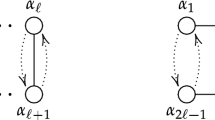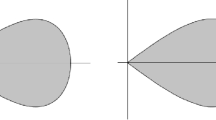Abstract
We show that the well-known fact that the equivariant cohomology (with real coefficients) of a torus action is a torsion-free module if and only if the map induced by the inclusion of the fixed point set is injective generalises to actions of arbitrary compact connected Lie groups if one replaces the fixed point set by the set of points with isotropy rank equal to the rank of the acting group. This is true essentially because the action on this set is always equivariantly formal. In case this set is empty we show that the induced action on the set of points with highest occuring isotropy rank is Cohen-Macaulay. It turns out that just as equivariant formality of an action is equivalent to equivariant formality of the action of a maximal torus, the same holds true for equivariant injectivity and the Cohen-Macaulay property. In addition, we find a topological criterion for equivariant injectivity in terms of orbit spaces.
Similar content being viewed by others
References
C. Allday, A family of unusual torus group actions, in: Group Actions on Manifolds, Contemporary Mathematics, Vol. 36, Amer. Math. Soc., Providence, RI, 1985, pp. 107–111.
C. Allday, V. Puppe, Cohomological Methods in Transformation Groups, Cambridge Studies in Advanced Mathematics, Vol. 32, Cambridge University Press, Cambridge 1993.
G. E. Bredon, The free part of a torus action and related numerical equalities, Duke Math. J. 41 (1974), 843–854.
W. Bruns, J. Herzog, Cohen-Macaulay Rings, Cambridge Studies in Advanced Mathematics, Vol. 39, Cambridge University Press, Cambridge, 1993.
H. Chen, An analytic model for S 3-equivariant cohomology, in Topology Hawaii (Honolulu, HI, 1990), World Sci. Publ., River Edge, NJ, 1992, pp. 53–61.
J. Duflot, Smooth toral actions, Topology 22 (1983), 253–265.
J. Duflot, The associated primes of H * G (X), J. Pure Appl. Algebra 30 (1983), no. 2, 131–141.
S. Eilenberg, J. C. Moore, Homology and fibrations, I, Comment. Math. Helv. 40 (1966), 199–236.
M. Franz, V. Puppe, Exact cohomology sequences with integral coefficients for torus actions, Transform. Groups 12 (2007), no. 1, 65–76.
M. Franz, V. Puppe, Exact sequences for equivariantly formal spaces, C. R. Math. Acad. Sci. Soc. R. Can. 33 (2011), 1–10.
R. Godement, Topologie Algébrique et Théorie des Faisceaux, Actualités Sci. Ind., no. 1252, Publ. Math. Univ. Strasbourg, no. 13, Hermann, Paris, 1958. Russian transl.: Р. Годеман, Алгебрацческая топологця ц теорця пучков, Иэд. иностр. лит-ры, М., 1961.
O. Goertsches, D. Töben, Torus actions whose equivariant cohomology is Cohen-Macaulay, J. Topology 3 (2010), no. 4, 819–846.
M. Goresky, R. Kottwitz, R. MacPherson, Equivariant cohomology, Koszul duality, and the localization theorem, Invent. Math. 131 (1998), no. 1, 25–83.
V. W. Guillemin, V. L. Ginzburg, Y. Karshon, Moment Maps, Cobordisms, and Hamiltonian Group Actions, Mathematical Surveys and Monographs, Vol. 96, American Mathematical Society, Providence, RI, 2002.
V. W. Guillemin, S. Sternberg, Supersymmetry and Equivariant de Rham Theory, Mathematics Past and Present, Springer-Verlag, Berlin, 1999.
V. Hauschild, Compact Lie group actions with isotropy subgroups of maximal rank, Manuscr. Math. 34 (1981), nos. 2–3, 355–379.
W. Y. Hsiang, Cohomology Theory of Topological Transformation Groups, Ergebnisse der Mathematik und ihrer Grenzgebiete, Vol. 85, Springer-Verlag, New York, 1975. Russian transl.: У. И. Сян, Когомологцческая теорця топологцческцх групп преобразованцй, Мир, М., 1979.
R. Kane, Reflection Groups and Invariant Theory, CMS Books in Mathematics/Ouvrages de Mathématiques de la SMC, Vol. 5, Springer-Verlag, New York, 2001.
P. W. Michor, Topics in Differential Geometry, Graduate Studies in Mathematics, Vol. 93, American Mathematical Society, Providence, RI, 2008.
А. Л. Онищик (ред.), Группы ц алгебры Лц, I, Итоги науки и техн., Соврем. пробл. матем., Фунд. т. 20, ВИНИТИ, М., 1988. Engl. transl.: A. L. Onishchik (Ed.), Lie Groups and Lie Algebras, I, Encyclopaedia of Mathematical Sciences, Vol. 20, Springer-Verlag, Berlin, 1993.
J.-P. Serre, Local Algebra, Springer Monographs in Mathematics, Springer-Verlag, Berlin, 2000.
Author information
Authors and Affiliations
Corresponding author
Rights and permissions
About this article
Cite this article
Goertsches, O., Rollenske, S. Torsion in equivariant cohomology and Cohen-Macaulay G-actions. Transformation Groups 16, 1063–1080 (2011). https://doi.org/10.1007/s00031-011-9154-5
Received:
Accepted:
Published:
Issue Date:
DOI: https://doi.org/10.1007/s00031-011-9154-5




